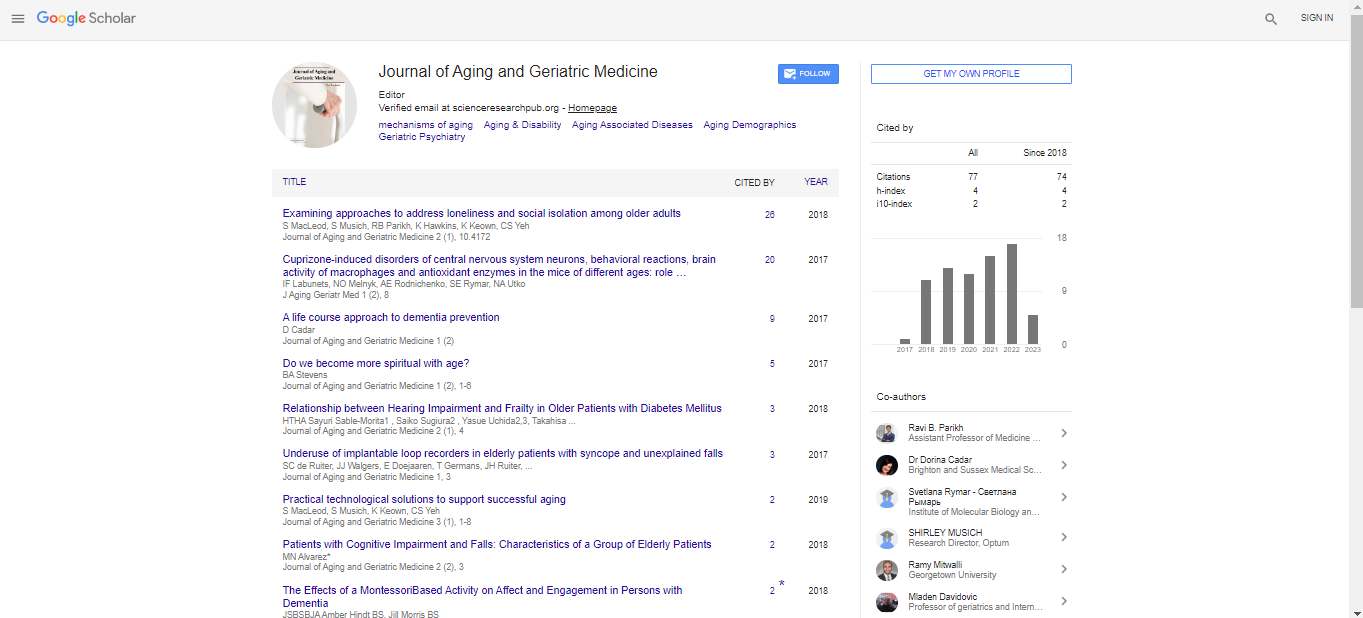Opinion Article, J Aging Geriatr Med Vol: 7 Issue: 3
Unraveling Dermatological Changes in the Aging Process
Zaynah Miot*
1Department of Dermatology, Federal University of Health Sciences, Porto Alegre, Brazil
*Corresponding Author: Zaynah Miot,
Department of Dermatology, Federal
University of Health Sciences, Porto Alegre, Brazil
E-mail: miotzaynah@gmail.com
Received date: 21 April, 2023, Manuscript No. AGM-23-102362;
Editor assigned date: 24 April, 2023, PreQC No. AGM-23-102362 (PQ);
Reviewed date: 15 May, 2023, QC No. AGM-23-102362;
Revised date: 22 May, 2023, Manuscript No. AGM-23-102362 (R);
Published date: 29 May, 2023, DOI: 10.4172/2576-3946.1000163.
Citation: Miot Z (2023) Unraveling Dermatological Changes in the Aging Processn. J Aging Geriatr Med 7:3.
Abstract
Description
Skin aging is influenced by demographic, environmental and lifestyle factors and skin type. The sun exposure is the most important factor. Exposure to the sun on visible areas of the skin affects the progression of skin aging up to 80%. The study showed that men had a significantly higher rate than women. Skin conditions and aging are closely related as the skin undergoes various changes over time. Aging itself is a natural process that affects all body systems, including the skin. While some changes are inevitable, there are certain skin conditions that can become more prevalent or exacerbated with age.
The basic substance of the skin are compromised, with decreased and dysregulated collagen synthesis and collagen degradation. With age, the number and diameter of elastic fibers decrease. Fragmentation, progressive cross-linking and calcification of elastin and collagen are evident, contributing to skin swelling and loss of elasticity. In both men and women, the total amount of subcutaneous fat decreases with age. In fact, body fat as a percentage of total body weight increases until age 70. Aging manifests itself as a redistribution of fat from the face and hands to the thighs and abdomen. At the same time, the body's muscle mass decreases with age, becoming more pronounced with age. The reasons for this are complex and include alterations in metabolism and hormonal homeostasis.
The dermis and epidermis becomes thin as we become older. It's possible to lose the fat layer underneath as well. A lot of changes occur as a result of the three skin layers' decreased volume and overall effectiveness. Some of the skin's suppleness is lost. Due to poor barrier performance and decreased production of vital oils like sebum, it becomes drier. Sensation is lessened as the number of nerve terminals in the skin declines. The skin's capacity to react to heat exposure declines along with the number of sweat glands and blood vessels.
Skin conditions associated with aging
Skin conditions are solely related to aging, and various factors, including genetics, lifestyle choices, and environmental factors, can contribute to their development. Proper skincare, including sun protection, moisturization, and a healthy lifestyle.
Wrinkles: Wrinkles are one of the most visible signs of aging. As the skin ages it loses its elasticity and collagen resulting in fine lines and deeper wrinkles.
Age spots: The age spots are flat brown patches that appear on the skin due to prolonged sun exposure. They typically develop in areas exposed to the sun, such as the face, hands, and arms.
Dryness: Aging skin tends to become drier and less able to retain moisture. This can lead to flaky, itchy, and rough patches on the skin.
Sagging skin: Loss of skin elasticity along with a decrease in muscle tone, can cause the skin to sag and lose its firmness. This is commonly seen in areas like the cheeks, jawline, and neck.
Skin thinning: With age, the skin becomes thinner due to a decrease in collagen and fat content. Thinning skin is more prone to injuries and bruises and may appear translucent or fragile.
Rosacea: While not directly related to aging, rosacea is a chronic skin condition that commonly affects individuals in their middle age and older. It causes redness, visible blood vessels, and sometimes pimples on the face.
Skin cancer: Aging skin is more susceptible to the development of skin cancer, primarily due to cumulative sun exposure over a person's lifetime. Regular skin checks and sun protection are essential to detect and prevent skin cancer.
 Spanish
Spanish  Chinese
Chinese  Russian
Russian  German
German  French
French  Japanese
Japanese  Portuguese
Portuguese  Hindi
Hindi 